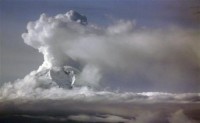Info from the Boston Globe and Alaska Volcano Observatory
Alaska’s Mount Redoubt continued its volcanic explosions Friday, sending ash clouds as high as 60,000 feet above sea level and prompting drivers to head to the auto parts store for new air filters. The National Weather Service said most of the ash was expected to fall to the north, but trace amounts of ash from eruptions on Friday and smaller ones overnight could fall on Anchorage itself.

Since the series of eruptions began Sunday night, the volcano has had several (actually closer to a dozen) bursts. One on Thursday sent ash 65,000 feet high. 5 eruptions followed Friday sending ash as high as 51,000 and 60,000 feet. The last time the volcano had erupted was during a four-month period in late 1989 and early 1990.

Two mudflows produced by the volcano Friday were moving down a slough and tributary toward the Drift River Terminal, where 6.2 million gallons of oil is stored, said Chris Waythomas, a geologist with the Alaska Volcano Observatory. A concrete-reinforced dike is holding the mud back and protecting the terminal’s oil storage tanks from damage. The Coast Guard said the plan was to keep the oil in the tanks instead of draining it. “The oil is safe where it is at right now,” said Coast Guard Cmdr. Joseph Losciuto.
Closer to Anchorage, the concern Friday was ash, a fear that proved mostly unfounded. There were no immediate reports of ash falling in the city. Airborne volcanic ash, even in relatively small amounts, can damage airplane and automobile engines. Because of the eruptions, Alaska Airlines, the state’s largest carrier, said there were limited flights in and out of Anchorage.

Follow Redoubt’s actviity at the Alaskan Volcano Observatory site here. Many pages of photos are included. The longer the eruptions continue and the stronger they are, the more climatic effects they are likely to produce. The more significant high latitude eruptions historically have led to cooler hemispheric summers, the failure of the African and Indian monsoon and a colder following winter with more high latitude blocking. Since high latitude blocking is favored at solar minimum years with a easterly QBO (Quasi-Biennial Oscillation) which is the case next winter, it could be interesting. Tropical eruptions like Pinatubo or El Chichon lead to a positive arctic oscillation and although the annual and winter global temperatures are colder than normal, western Europe and eastern North America tend to be milder than normal after tropical eruptions as a result.




